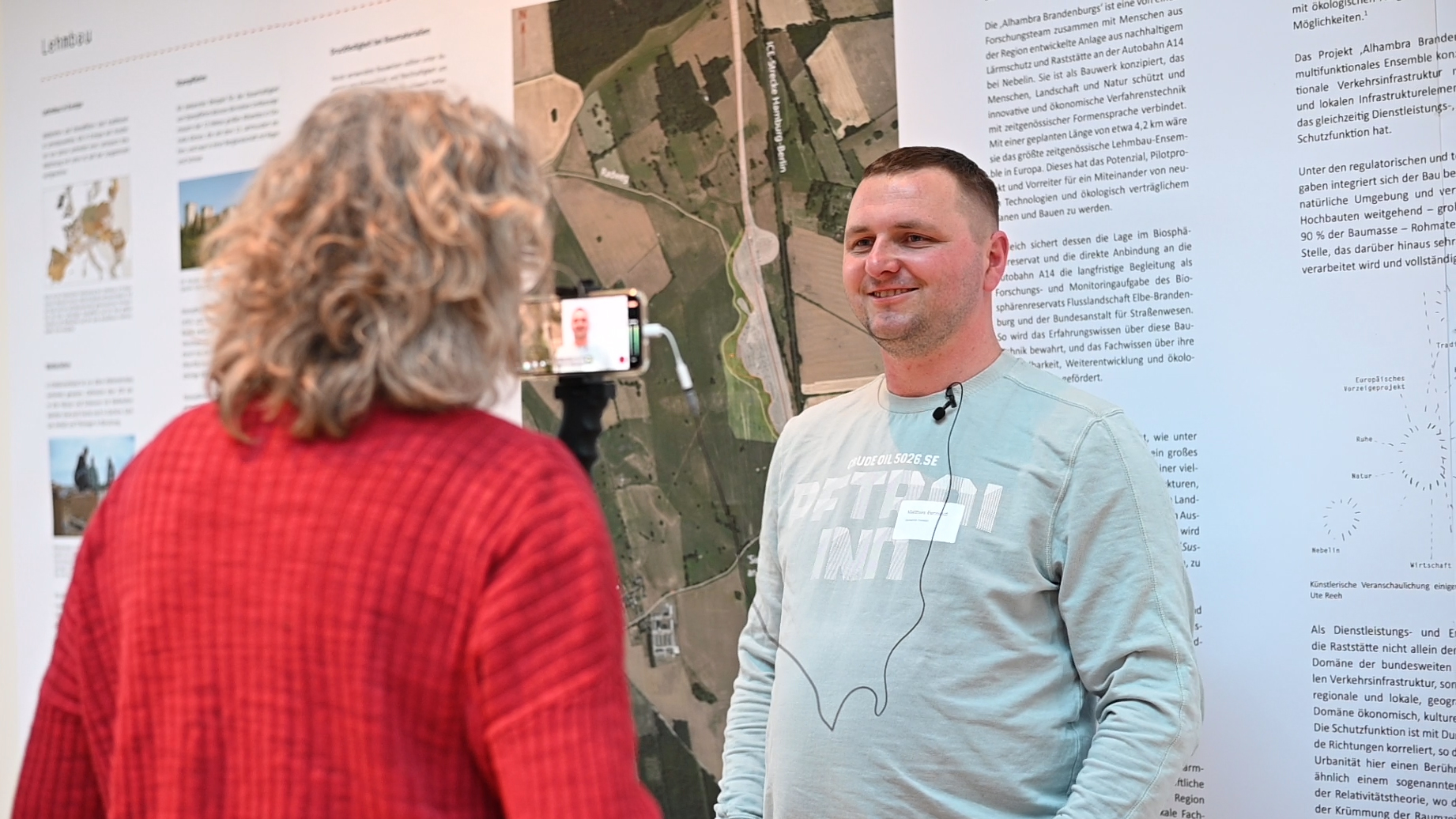Exhibitions on Brandenburgʹs Alhambra
Exhibition in the foyer of the Bundesanstalt für Straßenwesen (German Federal Highway Research Institute) in Bergisch Gladbach
14 October 2021 – 28 January 2022
The Federal Highway Research Institute is involved in the pilot project, in particular by carrying out or has carried out acoustic measurements and evaluations of various materials and surface structures envisaged for clay noise protection.
Exhibition in the foyer of the municipality of Karstädt
29 October 2021 – 13 January 2022
In the foyer of the Karstädt municipal administration, as a municipality involved in and affected by the project, the exhibition A motorway service station as a beacon project of contemporary building culture and pioneer of new technologies ‘Alhambra Brandenburgs’ – prototype for climate-neutral, durable and life-friendly solid clay building technology has been shown.
At the Nebelin site, an impressive network of different actors has been formed through the commitment of the Zentrum für Peripherie (Centre for Periphery), which has set itself the goal of using loam as a historical building material – available in the region and used for centuries – to make modern construction usable for contemporary building construction in the sense of the current climate problem.
(Christian Gadow, Head of the building office Karstädt, quoted in Prignitzer, 30.10.2021)
Exhibition at the Brandenburg State Representation in Berlin
22 March – 1 April 2022
The Brandenburg Ministry of Agriculture has funded the development of the concept of the Brandenburgʹs Alhambra, a motorway service area with gastronomy and conference centre in earthen construction in combination with a walkable and animated noise barrier, by the Centre for Periphery. The initiators of the project presented the special features and advantages of this innovative and climate-friendly construction method at the opening.
The concept of the Brandenburgʹs Alhambra presented in the exhibition is innovative and spectacular for several reasons. Here, as a pilot project, a building ensemble is to be erected that fits into the landscape using a locally available, climate-friendly building material that is sustainable in every respect. Traditional construction methods typical of the Prignitz region will be used. Last but not least, the involvement and active participation of various local actors can create added value for people and nature in the region affected by infrastructure measures.
(Anja Boudon, State Secretary for the Environment and Climate Protection)

Matthias Behrend, local chairman Nebelin. Interview rbb. Video still Daniel Beltran
Exhibition for the Convention of Building Culture 2022 of the Bundesstiftung Baukultur
03.05.2022 – 04.05.2022
Kunst- und Kulturquartier Schiffbauergasse, Potsdam
Desolate noise barriers for motorways – this does not have to be the case, as a current pilot project from Brandenburg shows. An initiative has developed a concept for an earthen noise barrier, but also for a motorway service area with catering and a conference centre in earthen construction. And the special thing about it: The building material is already available on site. […]
In a process lasting three years, the group developed a wealth of innovations. One focus was on increasing the compressive strength of Wellerlehm so that the old building technique meets contemporary requirements. Wellerlehm, with its high addition of straw, binds carbon sustainably. The exhibition presents the project on wall panels. Two films make the development process visible. The astonishing beauty of the material becomes visible on the basis of two test specimens. (Text excerpt from the programme booklet for the exhibition shown during the convention)
Spaces shape people – people shape spaces. […] Promoting the ability to perceive, speak and act for our built and ability to act in relation to our built environment through education in building culture is therefore a central concern of the Federal Foundation. After all, successful education in building culture is ideally followed by responsible participation in shaping our living spaces.
(Reiner Nagel, Chairman of the Board of the Bundesstiftung Baukultur (Federal Foundation for Building Culture))
Life cycle aspects should already be taken into account in the development, planning and construction phases of buildings, and buildings should be planned with an appropriate balancing system from the very beginning. Building culture criteria in favour of more sustainable construction methods, more valuable building materials and a higher architectural quality offer orientation on the way to life-cycle-oriented and economically successful construction methods. (Text excerpt from the programme booklet, on Forum 3 Customer-friendly building materials and life cycle)

Shared Vision. Lecture Ute Reeh Convention of Building Culture. Photo: Till Budde for the Federal Foundation for Building Culture
